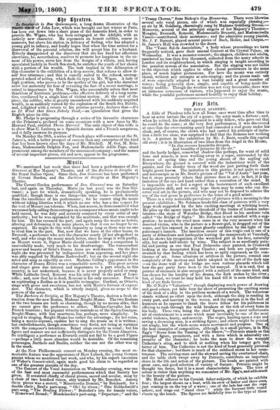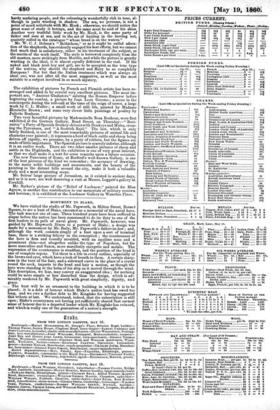i fint Arts.
TME ROYAL ACADEMY.
A fable of Phcedrus tells how all Rome once went time after time to hear an actor imitate the cry of a goose ; the actor made a fortune ; and, when he retired, his double appeared in a silly fellow, who gave out that he could do the same; at the very first performance, it was discovered at once that the over-cunning quack had concealed a real goose under his cloak, and, of course, the clown who had carried his principle of imita- tion a little too close, was surprised to find that the Romans saw nothing in it. A picture in the exhibition. by Mr. J. Brett, recalls this capital old story; it is in illustration of two lines from the Angel in the House, "In dim recesses hyahyacinthsdrooped,. And breadths of primrose lit the an." and the hardy hedger, somewhat shadow-like perhaps, for want of solid bone and muscle, is seen working away in a copse, surrounded by the flowers of spring time and the young shoots of the sapling oak
Everywhere, the ground is covered with the industrious work of the painter, and the slender trees of the wood are just putting forth their bright green leaves. The imitation in this picture is not quite so exact and microscopic as in Mr. Brett's picture of the "Val d'Aosta " last.year, but it stops precisely where that picture does in art; in fact, it Is the imitation of the eye and hand rather than a recreation of the mind. It is impossible not to feel a regret at the bestowment of such excellent manipulative skill, and we only hope there may be some who can dis- cover real art in the picture, and who may not be disposed to admire the cry of the real goose in preference to the voice of a good mimic.
There is a very noticeable prevalence of pictures with a meaning in the present exhibition ; Mr. Solomon heads this class of painters with a very large work suggested by the late exciting meetings at witching hours. He piles up the agony upon the threshold of the trades of London unfor-
tunates—the steps of Waterloo Bridge, that Hood in his sardonic vein called "the Bridge of Sighs." Mr. Solomon is not satisfied with a suir gestion ; he makes the cruel man come in at the very moment when his deserted victim, who in the picture is a flower-girl, is dragged out of the water, and lies exposed in a most ghastly condition by the light of the policeman's lantern. The heartless causer of this tragic end is one of a party of debardeurs and harlequins leaving the masquerade at Vauxhall, and he shows his recognition of the wretched girl in his face naturally silly, but made half-idiotic by wine. The subject is as needlessly pain- ful and jarring as one that Paul Delaroche once painted, in Cromwell looking at the decapitated King Charles ; and both arc equally unre- strained by that feeling which has been so aptly expressed, as the con- tinence of art. Some allusions or artifices in the picture, remind one completely of the mottoes and labels adopted in the art of the dark ago —on the stone wall of the bridge are seen various placards which tell how the gay party have been to the bal masque. It is is said, that s. painter of eminence is also occupied with a subject of the same kind, and has chosen for the locality of his drama, the dark arches by the river • but, at least, we trust he may hold his hand till it is seen whether this kind of art finds favour.
Mr. O'Neil's "Volunteer," though displaying much power of drawing
and good colour, yet falls very far short of presenting the exciting scene of the deck of a ship in the perilous moment of a wreck. The volunteer stands without an effort upon the deck, although the ship is rending in every part, and heaving in the waves, and the captain is in the best of humours as he appears to thank the brave fellow for his politeness in offering to rush through the wild breakers at the risk of every bone in his body. These two, being the chief figures, give a most unfortunate air of contentment to a scene which must inevitably be one of the most awful violence, hurry, and anxiety. The negro, hauling upon a rope and saving a drowning man, is a striking figure; and others might be pointed out singly, but the whole scene wants movement and purpose. One of the best examples of composition, although in a small picture, is in Mr; Egg's "Scene from the Taming of the Shrew,"—Petrucio stands as the principal figure, prominent, and with a force which is admirably ex.., pressive of the character; he looks the man to draw the waspiste Catherine's sting, and to stick at nothing when his temper gets the, better of him. The Catherine is not the kind of head generally pictured for that character; butthere is much of the subdued storm in her coun- tenance. The serving-man and the steward saving the overturned chair, and the table cloth swept away by Petrucio contribute an important share in the life and action of the picture. The heads are painted with great care and good selection of variety of feature : Petrucio might be thought too fierce, but it is a most characteristic figure. The tone of colour is richer than anything we remember of Mr. Egg's, and adds much to the beauty of the picture.
Mr. Hook adheres to his Cornish fisher-subjects, of which he exhibits four ; the largest shows us a boat, with its crew of father and three sons, just coming in on the top of a wave ; one of the lads has cast thepe ashore, and singe out "stand clear " ! while the buoyant little vessel entots up the beach. The figures are faithfully true to the type of these
hardy seafaring people, and the colouring is wonderfully rich in tone, al- though in parts wanting in shadow. The sea, we presume, is not a point of much solicitude with Mr. Hook ; otherwise, we should notice the great want of study it betrays, and the same must be said of his skies. Another very truthful little work by Mr. Hook, is the same party of father and sons at sea, and in the act of hauling in the herring net, quaintly called in the catalogue "whose bread is on the waters."
Mr. W. C. J. Dobson' s "Bethlehem," or as it might be called adora- tion of the shepherds, has evidently engaged his best efforts, but we cannot find much that is satisfactory, either in his treatment of the subject, or the merits of the work itself. The style is borrowed completely from the old masters, more strikingly from Murillo, and while the picture is greatly wanting in the ideal, it is almost equally deficient in the real. If the naked and black Arab boy and girl, are to be accepted as the true type of the natives, why should the shepherd and Mary be so completely European? Not but that the Italian treatment which was always an ideal one, was not after all the most suggestive, as well as the most suitable to a subject involved in so much mystery.
The exhibition of pictures by French and Flemish artists has been re- arranged and added to by several very excellent pictures. The most im- portant are, "Ancient Gladiators" saluting the Roman Emperor before beginning the combat, a picture by Jean Leon Gerome ; a scene in the conciergerie during the roll-call at the time of the reign of terror, a large work by C. L. Muller ; a small work of still life, painted by Madame Henrietta Brown ; and some very clever little paintings of poultry by juliette Bonheur.
Two very beautiful pictures by Mademoiselle Rosa Bonheur, were first exhibited at the German Gallery, Bond Street, on Thursday-" Buri- cairos" a Party of Spanish Donkey-drivers with Donkeys and Mules, cross- ing the Pyrennees, and "A Scottish Raid." The last, which is only lately finished, is one of the most remarkable pictures of animal life and character ever painted ; it represents a herd of black cattle and sheep being driven off rapidly, we presume, by a party of robbers, but the figures are made of little importance. The Spanish picture is scarcely inferior, although it is an earlier work, There are two other smaller pictures of sheep and cattle in the Highlands, and the exhibition is one of very great interest, so that we shall make it a text for some remarks upon a future occasion. The new Panorama of Rome, at Burford's well-known Gallery, is one of the best pictures of the kind we remember ; the accuracy of drawing, in the many noble buildings and monuments, and the beauty of the painting in the distant hills around the city, make it both a valuable study and a most interesting scene. Mr. Selous' large picture of Jerusalem, as it existed in ancient days, and as it is now, are well deserving a visit at Messrs. Leggatt's gallery in Comhill.
Mr. Barker's picture of the "Relief of Lucknow," painted for Miss Agnew, is another fine contribution to our memorials of military renown and heroism; it is exhibited at the Lucknow Gallery in Waterloo Place.



























 Previous page
Previous page